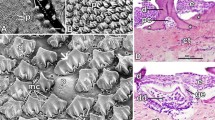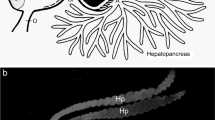Abstract
The benthic anomuran crabPagurus bernhardus (L) were collected from the North Sea near Helgoland, West Germany, during the years 1986–1987. The histological study of the integument ofPagurus bernhardus reveals a double structure with dorsal and ventral cuticular layers and with two epithelial cell layers. Additional structures have been developed within the integument to trap micro food organisms. The structure and function of the cupshaped glandular pockets of the integument is described. The cells which secrete mucus are also described. Histological and histochemical methods have been employed to study the chemical nature of various cells of the integument and the secretions of the glandular pockets. The ecological significance of the sensory hairs, glandular pockets, cuticular layers and the supra-branchial groove is discussed with reference to the crab's feeding mechanism.
Similar content being viewed by others

Literature cited
Bancroft, J. D. (1975). Histochemical techniques. Butterworths, London
Barnes, H. (1959). Stomach contents and microfeeding of some common cirripedes. Can. J. Zool. 37: 231–236
Boltt, R. E. (1961). Antennary feeding of the hermit crabDiogenes brevirostris Stimpson. Nature, Lond. 192: 1099–1100
Brightwell, L. R. (1951). Some experiments with the common hermit crab (Eupagurus bernhardus Linn), and transparent univalve shells. Proc. Zool. Soc. London 121: 279–283
Culling, C. F. A., Allison, R. T., Barr, W. T. (1985). Cellular pathology techniques, 4th ed. Butterworths, London
Dennel, R. (1960). Integument and exoskeleton. In: Waterman, T. H. (ed.) The physiology of crustacea, Vol. 1, Academic Press, New York, p. 449–472
Drach., P. (1953). Structure des lamelles cuticulaires chez les Crustacés. C. R. Acad. Sci. 237: 1772–1774
Efford, I. A. (1966). Feeding in the sand crabEmerita analoga (Stimpson) (Decapoda: Anomura). Crustaceana 10: 167–182
Erri Babu, D., Anger, K. (1987). The structure and modification of the integumental tissues inPagurus bernhardus (Linnaeus) (Crustacea: Anomura). J. exp. mar. Biol. Ecol. 112: 267–281
Erri Babu, D., Hanumantha Rao, K., Shyamasundari, K., Uma Devi, D. V. (1985). Histochemistry of the cuticle of the crabMenippe rumphii (Fabricius) (Crustacea: Brachyura) in relation to moulting. J. exp. mar. Biol. Ecol. 88: 129–144
Gerlach, S. A., Ekstrom, D. K., Eckardt, P. B. (1976). Filter feeding in the hermit crabPagurus bernhardus. Oecologia 24: 257–264
Grahame, J. (1983). Adaptive aspects of feeding mechanisms. In: Vernberg, F. J., Vernberg, W. B. (eds.) The biology of crustacea. Academic Press, New York, p. 65–107
Hackman, R. H. (1970). The integument of Arthropoda. In: Florkin, M., Scheer, B. T. (eds.) Chemical zoology, Arthropoda, Part B, Academic Press, New York, p. 1–62
Humason, G. L. (1965). Animal tissue techniques. W. H. Freeman & Co., London
Johnson, P. T. (1980). Histology of the blue crabCallinectes sapidus: a model for the Decapoda. Praeger Publishers, New York
Mazia, D., Brewer, P. A., Alfert, M. (1953). The cytochemical staining and measurement of protein with mercuric Bromophenol blue. Biol. Bull. mar. biol. Lab., Woods Hole 104: 57–67
Nicol, E. A. T. (1932). The feeding habits of the Galatheidea. J. mar. biol. Assoc. U.K. 18: 87–106
Orton, J. H. (1927). On the mode of feeding of the hermit crab,Eupagurus bernhardus, and some other Decapoda. J. mar. biol. Assoc. U.K. 14: 909–921
Pearse, A. G. E. (1968). Histochemistry, theoretical and applied, 3rd edn. Churchill Livingstone, London
Scully, E. P. (1978). Utilization of surface foam as a food source by the hermit crabPagurus longicarpus Say 1817. Mar. behav. Physiol. 5: 159–162
Skinner, D. M. (1962). The structure and metabolism of a crustacean integumentary tissue during a molt cycle. Biol. Bull. mar. biol. Lab., Woods Hole 123: 635–647
Travis, D. F. (1955). The moulting cycle of the spiny lobsterPanulirus argus Latrelle. II. Pre-ecdysial histological and histochemical changes in the hepatopancreas and integumental tissues. Biol. Bull. mar. biol. Lab., Woods Hole 108: 88–112
Author information
Authors and Affiliations
Additional information
Communicated by O. Kinne, Oldendorf/Luhe
Rights and permissions
About this article
Cite this article
Babu, D.E. “Glandular pockets” of the integument and feeding mechanism inPagurus bernhardus (Crustacea: Anomura). Mar. Biol. 99, 315–323 (1988). https://doi.org/10.1007/BF02112123
Accepted:
Issue Date:
DOI: https://doi.org/10.1007/BF02112123



